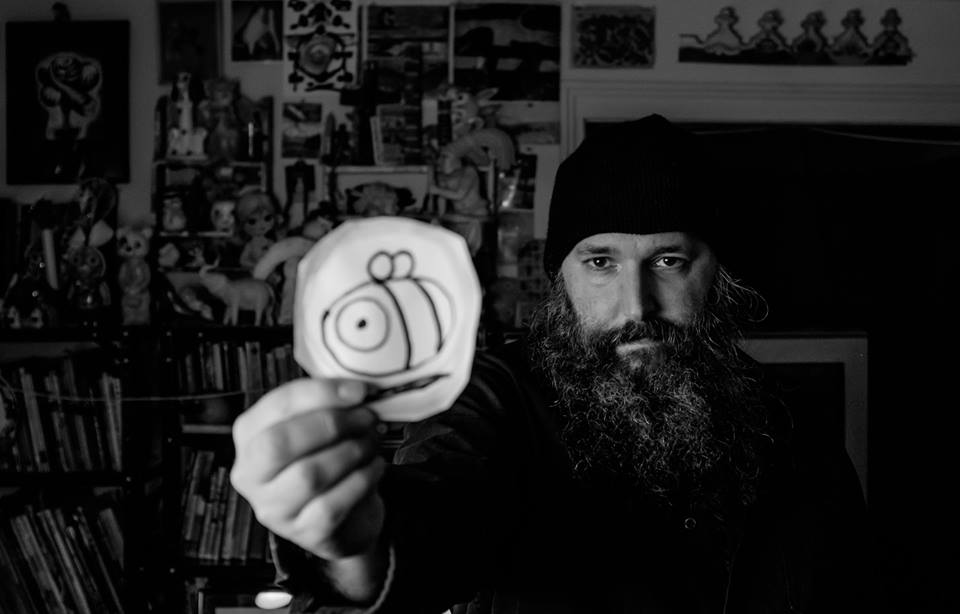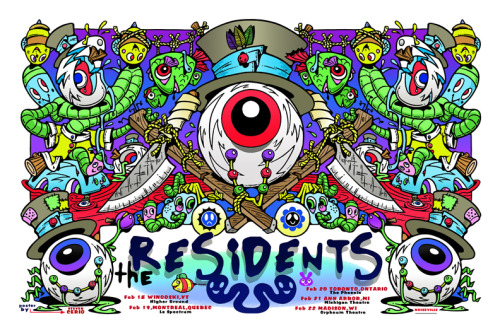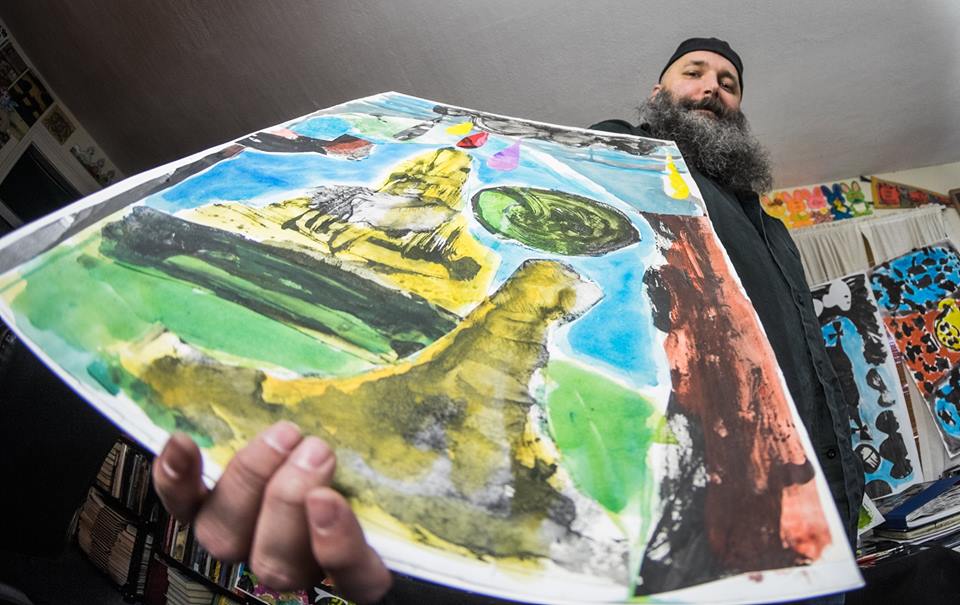Steven Cerio’s world is filled with the innocence and refreshing newness of childhood discovery. As an artist he communicates this animated sphere of his younger years through an extensive range of very detailed ink drawings and colorfully vibrant paintings of a myriad of joyful worms, bees, pig-tail girls, minnows, giraffes, and whales. Discover his boundless creativity in his free flow doodling in band posters, films, comics, books and music. Read about his early childhood experiences, his love for folk and outsider art, the useful self-marketing tips he learned from legendary artists and illustrators in NYC in the late 80s, his love for improvisation, abstract expressionism, and DIY thinking. Take this trip and delve into Steven Cerio’s magnificent and captivating macrocosm about all of the above and so much more in the interview!
At what moment in your life did you realize your calling as an artist?
I think it was really early for me, cause I found boxes of drawings that my mother saved. I think I was encouraged more than most because my dad – both my parents were first generation Americans, my mother’s family is from Yugoslavia and my dad’s was from Italy – he couldn’t afford to go to art school but he had skills and wanted to go but couldn’t so I think that’s why he enjoyed the fact that I liked drawing so much. If I even mentioned offhandedly, you know, asked like, “what’s oil paint dad?” we’d be in the car driving me to buy oil paint at 7 years old. And I got interested in typography early on, signs, and my father would take me to the museums. I think he was taking me partially hoping that I would be interested but he was interested in it himself. I think that got me on track at an early age. I used to say as a kid I wanted to be either an artist or an archeologist.
Do you have any of your dad’s paintings?
He didn’t paint a lot or draw a lot around the house, sadly. I wish everybody did. Sometimes I try to make people do it – pretty much anyone I was too close to in my family is passed away now. It would be so nice to have just a painting, a very simple painting that my grandmother did of her house or of a puppy, whatever. To me, well you know, I believe in art, it speaks to me, so to be able to answer “what is that weird bean shape on that canvas?” with “oh my grandfather did that; he was 82”. I wish I had stuff like that, but I do have this though, I have a painting that my dad did of a pot full of flowers, a still life that he did when he was showing me how to paint. He was showing me how to do shading and highlights. I have that exact painting, I kept it, I have it framed on my wall. And that thing is so strong to me it can drive me to tears on the right day. And I just wish that I had stuff that mother did, or my grandparents – not specifically for me but just a doodle or something. That would say a lot to me.
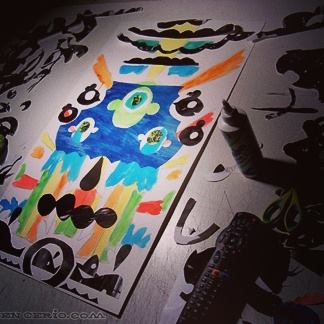 Were there artists on both sides of your family?
Were there artists on both sides of your family?
No, no one on either side of my family. No, they didn’t like doing it. I wish I had pieces by everyone of them though. No, there wasn’t a lot of that around me growing up. I just believe in anyone, even non artists. I think especially non-artists do the most interesting stuff anyway, I really do. I mean honestly the things I pay the most attention to since I was a kid are folk art and outsider art. I got into outsider art in NY in like ‘89 or ‘90.
What’s outsider art?
Outsider art would include a lot of folk artists of course, but it would be people that didn’t have any training, that weren’t doing work to have it be in galleries. It would be somebody like Henry Darger, one of the more famous ones. When he passed away they found in his apartment a book that was thousands of pages long and it had a lot of illustrations and paintings. There’s other ones, like the Philadelphia wire man. Someone passed away in an apartment and they threw away everything that was in there, all these abstract strange wire sculptures. That stuff speaks to me. Like to me the people who say they can’t draw, when they sit down to draw they have these unique styles. Dubuffet was the first one to promote it and use the term ‘art brut’ to describe it. And then you have a place called Gugging which is a mental facility in Austria and they started having people do drawings and paint every day, and they’re not painters and artists, and they created some of the most original and telling work. To me that flies in the face of all the training that people get, conceptualizing the way people do nowadays.
So, it’s like the natural trait in humans…
Right, it’s a human trait, it’s no longer a college graduate trait, or well educated trait, and to me that’s big, that’s strong human instinct. Look at someone like Howard Finster, one of the biggest folk artists in the world, one day he just decided that he was going to do sacred art, as he called it that was it, he just woke up one day and decided to do it. It’s an American thing. You see it in Europe and elsewhere but it seems to be a very common American occurrence. Waking up one day and going, “oh, I’m going to be a film director now”, you know, that was afforded to us back when there weren’t as many troubles as there are now, it’s still going on. 5-6 years ago, I got up one day, and decided, “I am going to start doing films” and then asked myself, “I never shot a film before, why am I going to do a film?”, and that’s why I started a film, because I had never shot one before. And I don’t know, I guess I carry around that Do it Yourself attitude, where if I don’t do a film one day I will look back and admit I didn’t do a film, but if I do a film, then I did a film. It’s as simple as that, right? And if you feel drawn to it then go ahead and do it. Going back to folk art, Grandma Moses decided, she was 72 or 73 when she started painting. You know, why not. Like some people are like – I wish I learned an instrument, and they’re like 40. You have plenty of time to learn an instrument. Pick up a guitar and play it your own way. If you are interested in it enough, you put in a couple hundred hours just messing with a guitar, you are going to start writing songs, you’ll start figuring out where your favorite notes are, you’ll start figuring out how to structure things or what appeals to you, I think it’s like that with everything. I wish there was more people that would do that, I wish there was mo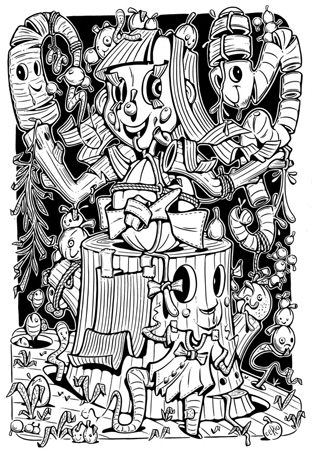 re naïve music out there instead of the worried, businessy dress up music that the labels award themselves for.
re naïve music out there instead of the worried, businessy dress up music that the labels award themselves for.
When you talk about composition and theory in art and music, it’s nonsense. It’s nonsense to educate on composition. That’s old silver haired white boy stuff that they still stick to. It’s not that I’m revolting against it. Now think about composition in music – John Coltrane- Cecil Taylor goes out, Ornette Coleman goes out, and they improvise completely. They learned structures/patterns, how to play a song, that there’s an introduction and a chorus, it’s not really that hard to learn. And you learn that stuff and when you go to improvise – Coltrane still created beautiful music even though it was improvised. If Coltrane just plays a theme at the beginning and just runs off that theme like Ornette Coleman did, who is to say that that’s not music or a composition. To predetermine doesn’t take skill or taste, just memorization. That is what music is, not pop music, it’s actual music. And these ideas from composition come from old classical techniques that the composers used but when you take rules away you realize most people invented their own rules anyway, Shoenberg, Cage and Varese. If you get different pieces of colored paper and you throw them on the ground a composition got created. Composition isn’t something that you need to go to school to be good at. Composition is something that just happens. I feel like a lot of these things that people believe they need to learn kept them from becoming an artist or musician, I think they could have just gone right past it. Composition and theory, theory is just that, it’s a theory. A person that just sits down and plays and starts doing music is going to have a catalog of 5000 new songs before a lot of these other musicians learned enough theory to improvise yet.
Do you use this same philosophy in the music that you write?
I sit down and play, if something works it works, if I enjoy listening to it I’ll continue working on it, and I’ll go that direction. There’s that instinct, if you are playing, even if you don’t have something written down, hopefully I know enough than to play a D sharp for 7 hours straight, you know what I mean? Some people think that if you don’t have something written down, if you don’t know where you are going you couldn’t go anywhere good. But if you get in your car and you drive you could very well wind up somewhere good if you keep driving long enough. That’s where I draw the line between what songs are and what music is. I think music, John Coltrane is music, I don’t think of John Coltrane as songs, I think of music as from higher level of thinking than that. Not that I think that there’s anything wrong with anyone listening to it or anything. I think at some point I grew out of the idea of songs. Grew out of the idea of even listening to them. If I know a verse is coming and I know a chorus is coming I get bored awfully quickly. Something might grab me for a little while but like most pop music it becomes disposable after a while. Where Coltrane, or Captain Beefheart say, even though his work was very structured, it’s hard to wear out. You could play the same song in a row for a decade and you still hear something different every time. I know it’s not for everybody.
Can you take me through the evolution of your artistic style?
When I started, the first thing when I started that I was in love with was the dictionary. It was the first thing that I saw that impressed me as a kid. I saw those tight engraved lines and I didn’t know anything about printing, I thought they were drawing all those little lines, and I thought those drawings were done that size too, I became fascinated with the idea of really tight line work when they brought out black ink in school, and then I saw the first Santana record. A friend of the family gave me a copy of the first Santana album, the Lee Conklin cover, it’s a drawing of a lion, and I was sitting around with it and I knew there was something up with it, I didn’t know what it was and I kept looking at it on and off for a couple of months and all of a sudden I saw the girls inside the eyes making up the nose and that’s when I started drawing. I asked my father for ink and I started drawing in ink, too much maybe –I got called into the school psychologist and I didn’t know what was going on, I thought I did something wrong. He sat me in a room and now that I look back, they were watching me through some glass or something, this was in the 70s. He watched me for a while and then he came out and the first thing I said to him when he came in was, “Is that a Boston pencil sharpener?” Because I loved Boston pencil sharpeners and you could see a lightbulb go off over his head, Ching!, cause that’s what I was there for. He asked “Why do you care if it’s a Boston pencil sharpener?”, and I reached into my pocket and I pulled out 5 pencils and he let me sharpen the pencils and then he asked, “Why are you sharpening those pencils?” and from my back pocket I pulled out a couple handmade sketch books that I had made out of folded paper. I would carry them to doodle during recess, and he asks “What are these?” and I go “Sketchbooks – I’m making sure the pencils are really sharp because I am doing detailed drawings” and he goes “Okay, you can leave.” They thought I was just obsessively sharpening pencils for no good reason, the reason why I would get up during class was because I wanted to draw all day. 10 years later I won a couple of scholarships to go to college to art school so it all worked out I guess.
I kept with the ink work, then I started giant scale charcoals and I 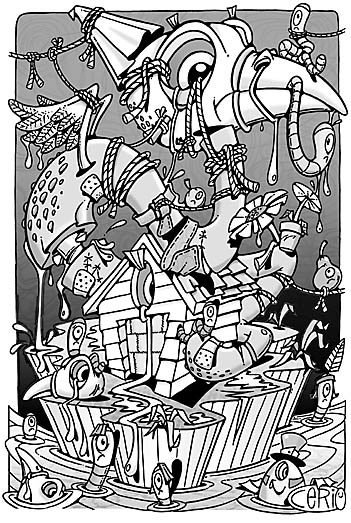 was painting a lot. When I was around 20, I was doing all ink drawings, I had moved away from color, just ink drawings. I switched from a technical pen to a brush in ‘90, and I worked with a brush ever since then. I started painting seriously somewhere around the mid-90s in a looser kind of style, sometimes almost completely abstract. It’s a completely different animal. I started showing the paintings now and I’m realizing how strongly people react to color. Cause to me I care more about composition more than I do about color. I had no idea, all of a sudden I’m doing work that people will hang in their living room and their wives will let them buy it. I think that the energy in my drawings is very aggressive to some people, it makes them nervous. So I am at both ends of the spectrum now, doing tight anal retentive drawings and really loose paintings. The way I see my stuff, even as a little kid I could see in my stuff, I’m always trying to build structures, they’re sketches for sculptures, and David Smith had a large part to do with that. It was one of the few sculpture books at the library in the town where I grew up, and I just adored it right off the bat. He was a big inspiration for me, still is. So a lot of my work is sketches for massive sculptures that I could never afford to make.
was painting a lot. When I was around 20, I was doing all ink drawings, I had moved away from color, just ink drawings. I switched from a technical pen to a brush in ‘90, and I worked with a brush ever since then. I started painting seriously somewhere around the mid-90s in a looser kind of style, sometimes almost completely abstract. It’s a completely different animal. I started showing the paintings now and I’m realizing how strongly people react to color. Cause to me I care more about composition more than I do about color. I had no idea, all of a sudden I’m doing work that people will hang in their living room and their wives will let them buy it. I think that the energy in my drawings is very aggressive to some people, it makes them nervous. So I am at both ends of the spectrum now, doing tight anal retentive drawings and really loose paintings. The way I see my stuff, even as a little kid I could see in my stuff, I’m always trying to build structures, they’re sketches for sculptures, and David Smith had a large part to do with that. It was one of the few sculpture books at the library in the town where I grew up, and I just adored it right off the bat. He was a big inspiration for me, still is. So a lot of my work is sketches for massive sculptures that I could never afford to make.
How did your poster making for bands come about?
Well that was one of the first gigs I got. I moved to New York, I got out of school in 87 and I was in NYC in 88, and people laugh about this but I moved there with $700 dollars in my pocket. That was enough to get situated back then, it was so cheap to live there, and the second day I was there I landed a job at Psychedelic Solution Gallery in the East Village. 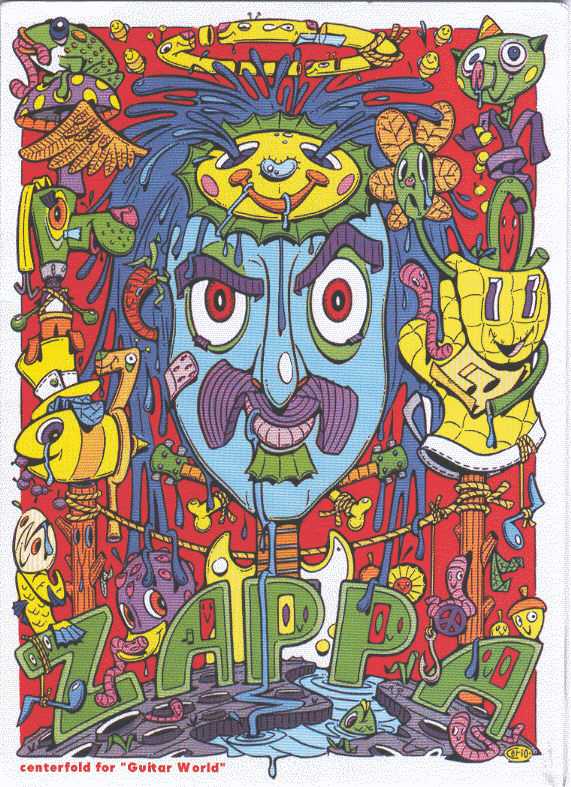 So I was working in a place where artists come in, Rick Griffon would come in, I got to know him, we’d have shows – artists would be coming through so I picked up a lot of advice from people’s work who I admired since I was a little kid. From there I started meeting people that would come in to look at art. My skin’s always been thick about art, it’s aesthetics, someone’s gonna like your work, someone’s gonna hate it, and I think I just knew that as a kid, I’m never really bothered, if someone doesn’t want to use me for a project I don’t become offended by it, I may not be good for the project or they may not like my work, I’m ok with that, it’s not really bothersome to me, I never let that get in the way. So every person that came in I was helping with a print I’d ask, “Are you in a band?” NY back then was all creative people, cause it was cheaper to live, you’d meet people that would make a living from having a little tiny record store in the back of a book store, everyone was doing something, but I’d ask enough and I met Kevin Hine who is one of the art directors for Screw magazine. He had me doing little spot illustrations for that and then I did a single cover for the Dust Devils, that was the first record cover I ever did, and from there I’d meet people, I did a poster for White Zombie before they broke really big, just a Xerox street poster, and I did some for Monster Magnet before they really broke through, so there was a lot of those bands around and people would come to me to do posters. Sometimes I would just accept a few beers for it, and the poster scene, there wasn’t really a poster scene back then, it was just Xerox street posters, it wasn’t until one day somebody came in with a Frank Kozik poster that we realized that anyone was still printing posters anymore because all the posters we were selling, nothing went past 1974, they were antiques that we were selling.
So I was working in a place where artists come in, Rick Griffon would come in, I got to know him, we’d have shows – artists would be coming through so I picked up a lot of advice from people’s work who I admired since I was a little kid. From there I started meeting people that would come in to look at art. My skin’s always been thick about art, it’s aesthetics, someone’s gonna like your work, someone’s gonna hate it, and I think I just knew that as a kid, I’m never really bothered, if someone doesn’t want to use me for a project I don’t become offended by it, I may not be good for the project or they may not like my work, I’m ok with that, it’s not really bothersome to me, I never let that get in the way. So every person that came in I was helping with a print I’d ask, “Are you in a band?” NY back then was all creative people, cause it was cheaper to live, you’d meet people that would make a living from having a little tiny record store in the back of a book store, everyone was doing something, but I’d ask enough and I met Kevin Hine who is one of the art directors for Screw magazine. He had me doing little spot illustrations for that and then I did a single cover for the Dust Devils, that was the first record cover I ever did, and from there I’d meet people, I did a poster for White Zombie before they broke really big, just a Xerox street poster, and I did some for Monster Magnet before they really broke through, so there was a lot of those bands around and people would come to me to do posters. Sometimes I would just accept a few beers for it, and the poster scene, there wasn’t really a poster scene back then, it was just Xerox street posters, it wasn’t until one day somebody came in with a Frank Kozik poster that we realized that anyone was still printing posters anymore because all the posters we were selling, nothing went past 1974, they were antiques that we were selling.
So how did you get involved with work for the Residents?
That happened by an old business technique where some of these older illustrators and gallery artists told me, don’t ever sit at home and wait for a gig, don’t do that, you go out and you knock on doors, that’s the way it’s done. Rick Griffin, Robert Williams, Ron Turner, Robert Crumb told me go and knock on doors, that’s the way you do it. And they didn’t mean as a beginner either, they meant as a professional artist, you knock on doors. That’s essentially what I did with the Residents, I got a mailing address for their office and I would spent $15 on Xerox copies, send them in, not hear anything back, send some more in, get a little note, and then one day they asked me to work on a film with them. Back then you used mail, the physical object, getting a physical object and holding it I still think has so much more power than getting an email. You can overlook an email but if you mail someone a 2-pound packet of Xerox copies of your drawings and they hold it in their hands and they wind up on their desk, you know they don’t get turned off, objects can’t get turned off, who knows, someone pins one up on a wall. I’ve sold art to people because someone they met had a poster of my work on their living room wall, or a postcard pinned on their cubicle at work. You can’t account for where people are going to see your works, putting actual copies out there still seems to me that it works much better than e-commerce.
Can you talk about some of the reoccurring characters in your work?
Yeah that goes in deep, all the way to my childhood, it takes a long time for a new character to be accepted into my stuff, I think carefully about that. All of the images I use started when I was a little kid, to me everything in there is suburban. The worms…I remember as a kid, I grew up in central NY, not a lot of sun, and I remember us calling each other and going “It’s a blue sky day” and looking up and having no clouds and having that beautiful blue sky, the green of the grass, certain things have a special resonance when you first start noticing them, I remember falling in love with lawn grass and finding toads and a puddle at the bottom of the driveway after it rained and there might be some worms in it. So you’d have this black pavement with this bright pink worm moving under the puddle and then you have a bright green frog hopping through bright green grass and to me there is a lot of poetry in all of that. It brings me back to those experiences and I remind myself of their beauty and because I’ve done that I’ve never forgotten. I talk to my friend Cindy, we’ve known each other since we were 3, and we talk about our neighborhood and the fields. She saw my art after we hadn’t spoken for a few years and said “I knew your art would look like that”, which I thought was great, and she remembered more stories than I did, like she remembered how obsessed I was with bees when I was a kid, which are still in my drawings, she goes “Remember the burning bees?” and I go “No..” I guess at one point my dad had a jar with some gas in it, he was cleaning screws, and I just emptied the gas out and I caught bees in it and we left it in the sun and it blew up cause of the fumes and we were freaked out, we didn’t know what was going on, some strange other worldly physics were going on. But all of those things like the yellow of the bees, of the yard, all of that, and building dioramas as a kid was a big thing with me and if you notice in almost all of my work has a short depth of field. I never use deep space, I never try to do reality, I never try to make something realistic, I’ve never been interested in it.
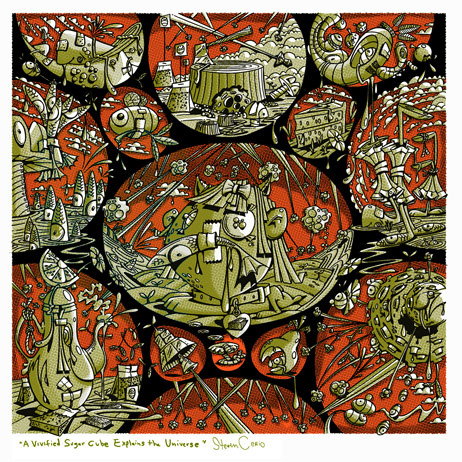 I was obsessed with view masters, I remember holding one on my face so long that I actually got bruises around my eyes from bumping into things. I wanted to be able to walk around and be in that Charlie Brown world. I kept hoping that if the light was just right I could still look at Charlie while I did my homework or while I was eating dinner. I think that’s where the love of shallow space comes from. To me, my work is all very innocent .I call myself a psychedelic artist but I don’t mean that in the most way that people use that term. I’m not a habitual drug user. I’m not saying I never had psychedelic experiences though. To me the psychedelic experience is just a pleasant sense of confusion. To get lost in something, to not know where you are for a while is very pleasant. I’ve experienced certain psychedelic states looking into a swimming pool and the light moving around, I don’t think it necessarily has anything to do with drugs, to me it’s just the way your brain is reacting to things. Alan Watts said, “after you get the call you can hang the phone up”, I think it was helpful to me, it helped me focus and realize things, but I don’t base my work in anything that’s happened to me, I’m on play not record, I want to confuse myself, I want to look at something and wonder why I did it, and guess at what state of mind I was in to make it, and I think that goes right back to my love for outsider art, if I am looking at a piece of art and can’t figure out why the person drew a fish or a house the way they did, I’m probably going to enjoy it .
I was obsessed with view masters, I remember holding one on my face so long that I actually got bruises around my eyes from bumping into things. I wanted to be able to walk around and be in that Charlie Brown world. I kept hoping that if the light was just right I could still look at Charlie while I did my homework or while I was eating dinner. I think that’s where the love of shallow space comes from. To me, my work is all very innocent .I call myself a psychedelic artist but I don’t mean that in the most way that people use that term. I’m not a habitual drug user. I’m not saying I never had psychedelic experiences though. To me the psychedelic experience is just a pleasant sense of confusion. To get lost in something, to not know where you are for a while is very pleasant. I’ve experienced certain psychedelic states looking into a swimming pool and the light moving around, I don’t think it necessarily has anything to do with drugs, to me it’s just the way your brain is reacting to things. Alan Watts said, “after you get the call you can hang the phone up”, I think it was helpful to me, it helped me focus and realize things, but I don’t base my work in anything that’s happened to me, I’m on play not record, I want to confuse myself, I want to look at something and wonder why I did it, and guess at what state of mind I was in to make it, and I think that goes right back to my love for outsider art, if I am looking at a piece of art and can’t figure out why the person drew a fish or a house the way they did, I’m probably going to enjoy it .
What about the whales in your art?
I went on a whale watch out in Maine and they were swimming right along the ship, I was able to pet a couple of them, they were babies. I met whales – I was out there in the water with them, I was out in California, I saw whales out there – didn’t draw whales, for years I didn’t draw whales. You think that that experience alone would trigger something. No, it took 8 years. Things have to feel right, there has to be a reason- not necessarily rational- why it’s there. Sometimes I’ll put something in and it doesn’t look like it belongs, like even my giraffes. My giraffes aren’t really giraffe’s, they’re toothpaste. I was doing a drawing one day and I drew some toothpaste squirting out, it was a tube with a chopped off end like a log, and then I drew an eye on it, so in my head it’s ok having toothpaste in a drawing about the suburbs and my childhood ’cause it just reminds me of the Crest tubes. There’s always bees, there’s always lawn grass, and there’s always worms, that’s been in everything for about 20 something years. But if I have water now I have I certain type of minnow I draw all the time because I had been up by a river, hiking up in the Adirondacks, and there was one dead silver minnow laying out on a rock, perfectly laid out on a dry rock. It looked like it had only been there for a half hour and it just struck me for some reason, like the shape of it, and how silver it was and how big the eye was and I took a bunch of photographs of it and then I started drawing minnows the next day. It just made an impression on me, it came into my work organically.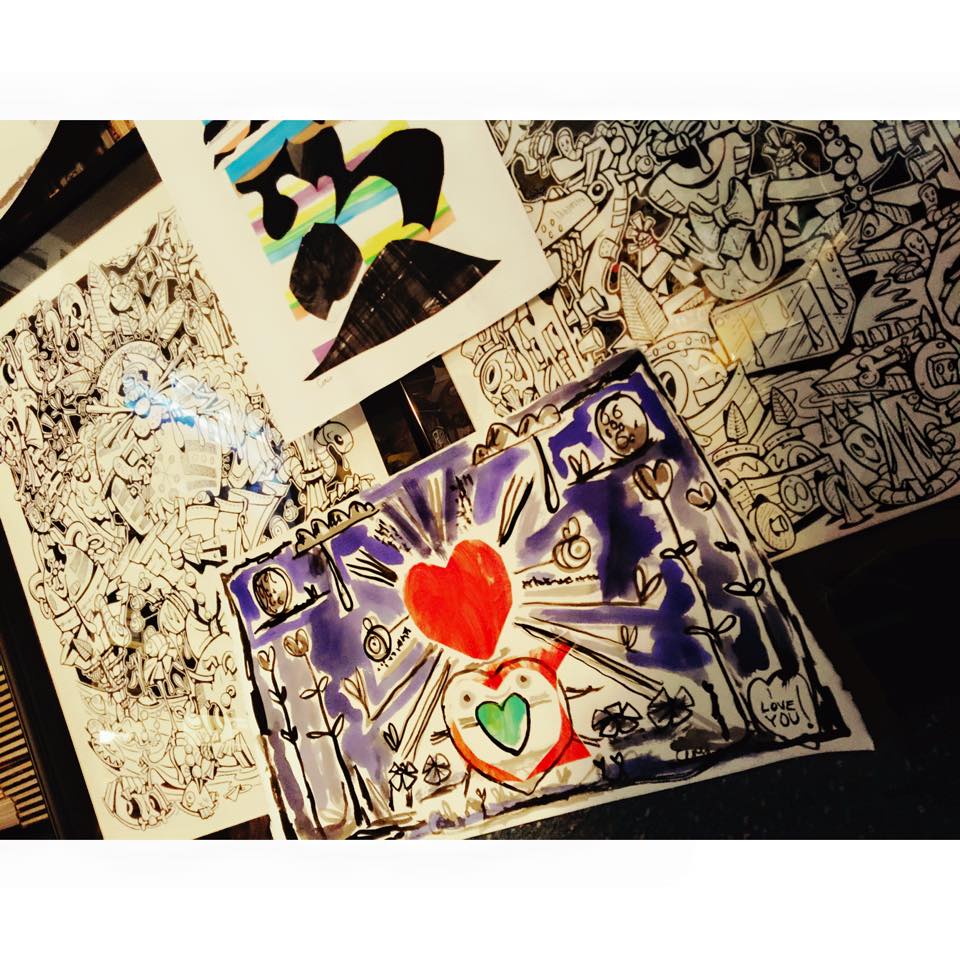 To me it’s comfort food, art is comfort food to me, it makes me feel good. I don’t do irony or politics, to me art should be about confused comfort and pleasure, some people get it, the people that like my work get it. Everyone wants to feel better, no matter how many skulls and graveyards they tattoo on themselves.
To me it’s comfort food, art is comfort food to me, it makes me feel good. I don’t do irony or politics, to me art should be about confused comfort and pleasure, some people get it, the people that like my work get it. Everyone wants to feel better, no matter how many skulls and graveyards they tattoo on themselves.
Can you describe your studio space? ? What environments are you most comfortable or enjoy most working in?
I think the one thing I took from the environment living in NY was the horror vacuous approach of it all; televisions playing in windows and all the trains back then, this was the late 80s when I just got there so the trains were still really beautiful. They were big beautiful murals rolling through the city. We’d all stop and watch the # 7 trains go by, they were just painted from top to bottom. Even riding those trains was a treat. I already had those kind of horror vacuous instincts, the idea of activating every available space, but I was still drawing nature, I never really found cities, boxes and squares very beautiful, but after I moved up to the Hudson valley in the Catskills my style really started changing a lot quicker. I never thought much of inspiration, I never thought that I needed to be inspired by anything outside of me, just like Picasso said – inspiration is just fine but when it shows up it better catch you working – I’m paraphrasing but that’s the essence of it. I got up there and found giant centipedes and caught frogs on the way home, after being in NYC all day I’d stop at a pond on the way home, and be careful not to hit raccoons on my bike when I was going to get pizza in the evening. That really inspired me. Nature started becoming increasingly important in my work. Even now though I’m technically in a suburb but separated by big lots, being able to go out in the garden every day helps me get a lot of work done, my brain just opens wide up. The pollen, the bees, just the color green, I love the summer. For my studio set up I keep everything in the same room, one giant room where I have all of my books, the television is in here so I can leave movies on, the stereo, my computer, two drawing tables, a surface for cutting stuff and trimming stuff. A brain where you can go in there and there’s all this activity going on and hopefully some of it grabs you. Everything is an arm’s reach away. I’m stalked up on pencils, erasers and ink and there’s stacks of unfilled notebooks. I love the idea that there’s paper I haven’t drawn on yet. I like knowing there’s tons of work that I still need to do. That really inspires me knowing that there’s all that blank paper in the world. I love facing an empty canvas, I love facing empty paper, I love it, because there’s nothing there and when you are done there’s something there.
I’m trying to remember a long time ago I think you told me how you enjoyed working in the south west, maybe Arizona…
Yeah, I’m very attached to that area, especially the southwest corner of Arizona. My friend Dave and I used to fly out there about every year or two years and go out there to hike and drive every road we could and mark it on the map, all through New Mexico and Arizona till we found something interesting. I fantasized about living out there, the idea to me of just having nothing to do but work sounds beautiful to me. I don’t hate people but I like the idea of being out there in the middle of the desert and no one’s going to disturb you. Of course that was pre cell phone days, but to really be in the world, I know it sounds simple and almost hippyish but the idea of being in the world and getting wet when it rains- being there in the elements. I brought my mother’s ashes out there to Arizona near Organ Pipe National Monument. When she passed away I brought her ashes out into the desert. I like thinking of her ashes being there cause it’s so incredible the view, you can see 20 miles into the desert from where I climbed and that’s what my movie was about, The Magnificent Pigtail Shadow. The idea came from that day where I was up on the mountain and a bird followed me up and all the way back down then sat underneath the car. My half-sister Michelle said – “That was your mother!” – and I go – “My mother followed me down and sat in the shade of a rental car and ate potato chips from a bodega in Tucson?” – and I found that insulting (laughs)! No, my mother didn’t inhabit a bird and eat Ripples underneath our Ford rental car! When I was up there laying out her ashes, I took some photos. Only in Arizona can you have really strange shadows casted from rock formations you can’t see from where you are, and there was this rock casting a shadow that looked like a girl with pigtails. It reminded me of a picture of her when she had pigtails when she was getting her communion as a little blond girl in Simpson, Pennsylvania. For a second I thou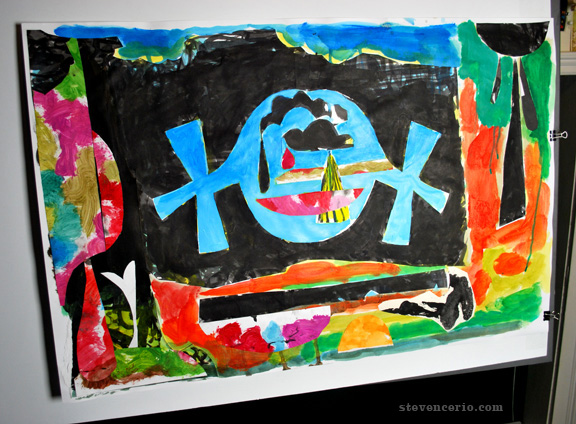 ght, “wow that looks like that photograph” – but I don’t go for superstition or mysticism so I was bothered by the fact that my brain was trying to make me believe that her spirit was moving in strange fantastic ways and I rejected it and I still reject it but when I got home and showed my sister that picture, and she said that- “that was your mother!” – it didn’t make me angry at my sister but it made me realize how un-superstitious I am, how un-spiritual I am, and for a while I felt a little bit guilty about that. One would assume that I am a cold person but I’m not – I just believe that we should do whatever we can while we are here. We should enjoy this world as much as you can while we are here. The movie is about that sensation, it doesn’t have a sinister tone to it but it’s slightly mocking, like oh, you can think of something better than this desert or that beautiful tree, you’ve got something better, what is it, a vision of heaven that you’ve never seen that someone sold you on that they invented and you are going to wait for that instead of enjoying where you are here? I’m not trying to attack religion but superstition is fascinating to me. I’m using images of the earth and laying them on top of one another and it looks very meditative and very psychedelic so technically speaking, me doing a film isn’t me being here and enjoying the world either, it’s me doing a film to tell everyone that they should enjoy the earth (laughs). Creating art isn’t enjoying a sunset either.
ght, “wow that looks like that photograph” – but I don’t go for superstition or mysticism so I was bothered by the fact that my brain was trying to make me believe that her spirit was moving in strange fantastic ways and I rejected it and I still reject it but when I got home and showed my sister that picture, and she said that- “that was your mother!” – it didn’t make me angry at my sister but it made me realize how un-superstitious I am, how un-spiritual I am, and for a while I felt a little bit guilty about that. One would assume that I am a cold person but I’m not – I just believe that we should do whatever we can while we are here. We should enjoy this world as much as you can while we are here. The movie is about that sensation, it doesn’t have a sinister tone to it but it’s slightly mocking, like oh, you can think of something better than this desert or that beautiful tree, you’ve got something better, what is it, a vision of heaven that you’ve never seen that someone sold you on that they invented and you are going to wait for that instead of enjoying where you are here? I’m not trying to attack religion but superstition is fascinating to me. I’m using images of the earth and laying them on top of one another and it looks very meditative and very psychedelic so technically speaking, me doing a film isn’t me being here and enjoying the world either, it’s me doing a film to tell everyone that they should enjoy the earth (laughs). Creating art isn’t enjoying a sunset either.
Can you talk about or describe the various techniques you use?
The paintings I’ve been showing, I hadn’t shown them for years. Doing the tighter style that I do which is the really tight polished style with the brush, I call it the germ free style. But that stuff is a stunt, I don’t draw like that in my sketch book. I have to control my breathing when I do those, there’s a specific brush I use and there’s no mistakes on them. Since I was a kid I liked the idea of art just coming out of you-happening to you. I think of the great folk artists and outsider artists as cavemen – they did what they had to do to get the image down or to create the object, they didn’t care what they made it out of. Look at Salvation Mountain, its’ made out of mud. He needed to get that image out in the world and he couldn’t afford cement so he was making adobe out of mixing water with the dirt that was out there in the desert. I approached art initially as a little kid, and at this point the pieces that I do have no performance anxiety in them at all, there’s no test to me in it at all, it is me getting an image down. I put a color I don’t like down I’ll either paint over it or I’ll tear it right off cause I paint on paper now, I stopped painting on canvas, it was starting to take up too much room and I just liked the absorbency of paper better and I like the texture of paper better and I didn’t enjoy spending hours preparing for every painting or drawing. On paper I can do work on 6 paintings at the same time, and there’s not much prep time involved really, and there’s no such thing as mistakes anymore and sometimes they wind up being fifteen layers of paper and weighing a couple of pounds, but in the end the image comes out the way I want the image to come out and they follow that caveman approach where I’m going to get this image down no matter what. It’s an attitude that has nothing to do with style, it’s not a statement in itself, it is only the urgency of getting something accomplished, something recorded, something done, something out there, I hesitate to ever use the word expressing because that word seems odd to me, like I don’t really feel like I’m trying to tell anyone anything and I think expression means you are trying to tell somebody something, I’m not trying to tell anybody anything. It’s about structure and it’s about beauty. I think of it as art of course, but a bit like putting in a bathroom floor in a way. I think of it as what my dad did being a carpenter. Those instincts sound ‘selfish’ in this age, but art is selfish, or at least it used to be .Now the art world wants art to be ‘socially redeeming’, but I didn’t get into art to illustrate American politics. I feel like a lot of gallery art has become very illustrative where abstraction has become a dirty word, like it’s something that self absorbed people did instead of painting the US flag dripping its red stripes like blood. I’m not inspired by CNN to do art.
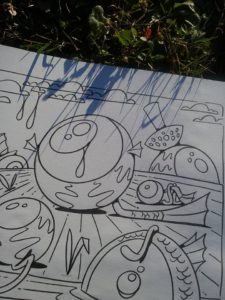 When you are facing a blank sheet of paper do you know what you are going to draw?
When you are facing a blank sheet of paper do you know what you are going to draw?
I will definitely have an intentionally loose idea of how I want something to come out. It’s usually from the most simple thumbnail sketch imaginable and I’ll keep it on the wall while I’m doing the piece. The inspiration is often a simple shape. Everything comes off that big shape. I’m always thinking sculpturally. A thumbnail that took me 3 seconds to draw might talk to me for some reason. The sketches that I really prepare for I rarely end up using ’cause I feel like I already know what they look like in my head so there’s no mystery in it for me anymore. If I plan too much the mystery is gone for me. It’s the same thing for me in music, if I know where the verse and the chorus is and how long the song is and when it’s going to end I don’t want to play it anymore. I kind got really fed up with playing pop structures and songs. I wanted to sit down and do music and play music like you go for a walk, like you think, and what happens, happens, and when it ends, it ends. You don’t really know exactly how long it’s going to be, you just need to have that mystery, the possibilities and open-ends of it is what inspires me. But with my paintings I’ll start with nothing. I’ll start making gestures on the paper and just feeling out. There’s no performance anxiety, it’s just jump in, sink or swim, but really, there’s no sinking because I can always tear out the part that I don’t like.
Do you ever get commissions for work?
Galleries, commissions and book/print sales is how I make a living.
Do you still do posters?
People usually don’t tell me what to do when they want posters done. It was back in the 90’s, I worked for Entertainment Weekly and Nickelodeon and all that and it was very precise stuff, like we need a dog and the dog needs to be this color, or the article is about this person, do a portrait of them. It was easier doing that than, you know, cleaning dishes, for me. I could make more money doing that so I kept at it for a few years. Most of the commissions now are for paintings, I’ve been doing more paintings than usual and then some people will commission posters and graphics for bands and what not. I’ve been working on a lot of books now, the one sad thing about book publishing now is that there is no such thing as advances anymore.
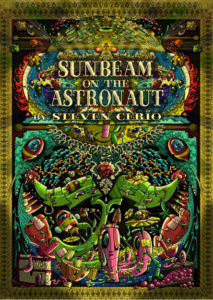 Can you tell me about your book, Sunbeam on the Astronaut?
Can you tell me about your book, Sunbeam on the Astronaut?
It was a collection of what I wanted in narrative work. I like abstraction in writing. I used many of my automatically written shorts alongside veiled stories of my sister’s death, hallucinations and dreams. It is far from a comic but has some influence of 60s undergrounds. I used any style needed to push the writing. I often invented styles for a specific piece. Its being re-released as a boxset with my new book Charming the Sugarbowl– a full color collection of my paintings. The box will also have a collection of my music and films.
Can you talk about your whole toy making experience?
I was talking to a friend about ideas for The Residents toys that I wanted to do. I had the blessing of The Residents to do it, and he had just met Lev from Toy Tokyo, so we made plans to go down. Lev at first wasn’t too thrilled with the idea. I am sure he has to say no to like a thousand toys a day I would guess, but he kept a few images from me and then a month later he called me, and I lied and told him that I knew how to make toys. I called up some friends who knew 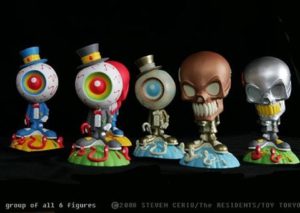 how to design toys, found out it wasn’t horribly detailed and I didn’t need to go to school for 8 years to learn how to do it so I jumped in, got it done. I ran everything past the Residents and we were good to go. I told that story to my students and they didn’t seem to think I really got the gig was their impression. They thought asking someone for a job doesn’t really mean that you got the job, that you were essentially begging for it. They seem to think you get on a TV show or win a contest and the next morning you wake up to a career. I hope that magical thinking works for ‘em, but I haven’t seen any evidence of it. There’s only so much I could do teaching seniors that had never been taught any business at that school. I think if you go into art school you should be learning business at the same time. I’m not saying that you have to be like Andy Warhol where 99% of your day is business. It’s often painful for me. I don’t really dig the business side of things but I don’t hate it either, and I know that it’s necessary, I know that promoting my art gets me more commissions, gets me more gallery shows, gets me more books, and that gets me more work to do so I can use up all that paper in the corner.
how to design toys, found out it wasn’t horribly detailed and I didn’t need to go to school for 8 years to learn how to do it so I jumped in, got it done. I ran everything past the Residents and we were good to go. I told that story to my students and they didn’t seem to think I really got the gig was their impression. They thought asking someone for a job doesn’t really mean that you got the job, that you were essentially begging for it. They seem to think you get on a TV show or win a contest and the next morning you wake up to a career. I hope that magical thinking works for ‘em, but I haven’t seen any evidence of it. There’s only so much I could do teaching seniors that had never been taught any business at that school. I think if you go into art school you should be learning business at the same time. I’m not saying that you have to be like Andy Warhol where 99% of your day is business. It’s often painful for me. I don’t really dig the business side of things but I don’t hate it either, and I know that it’s necessary, I know that promoting my art gets me more commissions, gets me more gallery shows, gets me more books, and that gets me more work to do so I can use up all that paper in the corner.
Visit Steven Cerio’s website to get lost in the gleeful abundance of his work in a multitude of mediiums!
